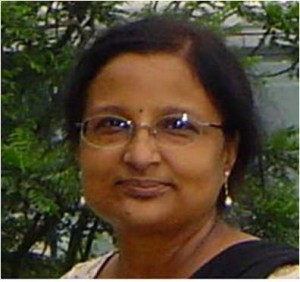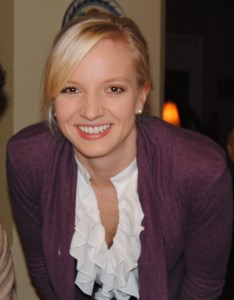 Our first author, Dr Santa Chawla, works at the CSIR National Physical Laboratory in New Delhi (India), where she is Associate Dean of Physical Sciences and also professor of the Academy of Scientific & Innovative Research. Her research centres on the development of phosphor nanoparticles for the enhancement of solar cell efficiency through solar full-spectrum conversion.
Our first author, Dr Santa Chawla, works at the CSIR National Physical Laboratory in New Delhi (India), where she is Associate Dean of Physical Sciences and also professor of the Academy of Scientific & Innovative Research. Her research centres on the development of phosphor nanoparticles for the enhancement of solar cell efficiency through solar full-spectrum conversion.
With several colleagues, Santa’s paper reports their latest efforts to develop materials for efficient energy harvesting. In this paper, a single phosphor with dual excitation and dual emission properties has been fabricated. Their material also shows plasmonic enhancement of the fluorescence. Such a material with intense red and green emission can be very useful for simultaneous conversion of solar UV and IR to visible radiation.
When not in the lab, Santa enjoys both reading and travelling.
Fabrication of dual excitation dual emission phosphor with plasmonic enhancement of fluorescence for simultaneous conversion of solar UV and IR to visible radiation
by Santa Chawla, M. Parvaz, Vineet Kumar and Zubair Buch,
New J. Chem., 2013, 37, 3991–3997. DOI: 10.1039/C3NJ00889D (Paper)
 Julia Bayne co-authored the Focus review on pigments with Prof. Ian Butler. While participating in the Inorganic Chemistry Exchange Program during the summer of 2013, Julia worked in Ian’s materials science laboratory at McGill University (Montreal, Canada), which specialises in variable-temperature and high-pressure micro-Raman spectroscopy of artists’ pigments. Temperature and pressure-dependent structural changes of artists’ pigments play an instrumental role in art conservation and the determination of forgeries. Additionally, the stability of the pigments noted in their paper reinforces their continued long-term use in artwork.
Julia Bayne co-authored the Focus review on pigments with Prof. Ian Butler. While participating in the Inorganic Chemistry Exchange Program during the summer of 2013, Julia worked in Ian’s materials science laboratory at McGill University (Montreal, Canada), which specialises in variable-temperature and high-pressure micro-Raman spectroscopy of artists’ pigments. Temperature and pressure-dependent structural changes of artists’ pigments play an instrumental role in art conservation and the determination of forgeries. Additionally, the stability of the pigments noted in their paper reinforces their continued long-term use in artwork.
Julia is currently a 4th year undergraduate student at the University of Ottawa (Canada) in the chemistry honours programme. She is conducting research in an organometallic laboratory, exploring the synthesis and reactivity of transition metal catalysts with respect to perfluoroalkene polymerization.
When not in the lab or immersed in a chemistry textbook, Julia practices yoga or weight-lifting, aiming to improve her “physical” chemistry.
Effect of temperature and pressure on selected artists’ pigments
by Julia M. Bayne and Ian S. Butler,
New J. Chem., 2013, 37, 3833–3839. DOI: 10.1039/C3NJ00955F (Focus)
 Our last author for this month is Dr Igor Sivaev, who is a senior researcher working in the area of boron chemistry at the A.N.Nesmeyanov Institute of Organoelement Compounds in Moscow (Russia).
Our last author for this month is Dr Igor Sivaev, who is a senior researcher working in the area of boron chemistry at the A.N.Nesmeyanov Institute of Organoelement Compounds in Moscow (Russia).
Igor’s current research project is the synthesis of functional derivatives of carboranes for incorporation in various bio- and nano- molecules. Igor explains the significance of this work by quoting one of his countrymen:
“Chemistry has widely spread his hands in human affairs” said Mikhail Lomonosov, famous Russian scientist encyclopedist in the middle of the 18th century. Today these words are associated in the best way with the chemistry of polyhedral boron hydrides (boranes, carboranes, metallacarboranes, etc.) that find applications in such different fields as cancer diagnostics and treatment, liquid crystals, nonlinear optic materials, catalysts, molecular machines and many others. Therefore I chose NJC to publish this research work because the journal is addressed to a cross-disciplinary and wide readership.
In his free time (when he has some) Igor reads non-fiction works and enjoys travelling to different places with historical or cultural significance.
Synthesis of new ω-amino- and ω-azidoalkyl carboranes
by Marina Yu. Stogniy, Igor B. Sivaev, Ivan A. Godovikov, Zoya A. Starikova, Vladimir I. Bregadze and Shicheng Qi,
New J. Chem., 2013, 37, 3865–3868. DOI: 10.1039/C3NJ00677H (Letter)
A very warm thanks to our three authors who agreed to play the game and reply to a few questions.










